|
Update: We have created a Flickr Group for participants to share their photos of the event.
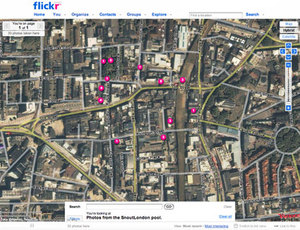
Images from today's event will be posted in the next few days, meanwhile the 'scavenged' web interface is now public at:
http://snoutlondon.ning.com
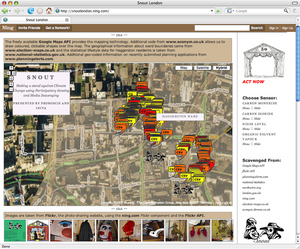
The site shows the sensors readings collected during the performance today together with a variety of other public data and services designed to make connections and give context to pollution in our environments. The site has been developed by Karen Martin and is built using ning.com – a free online service providing templates for building social networking sites with little or no programming ability. Woven into the ning site are mapping technologies from Google, photofeeds from Flickr, RSS feeds, ward level statistics (Census 2001) from National Statistics and links to other services such as writetothem.com, upmystreet conversations and local organic food delivery.
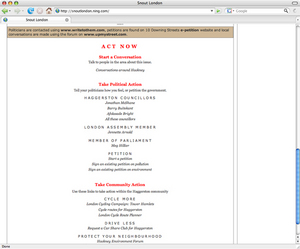
Update Kevin Harris of Local Level has blogged his impressions of the performance and forum, speculating on the role of this kind of public intervention in defusing community tension.
Chris Hand has also blogged the event and posted his photos on Flickr.
Andrew Curry has also blogged the event on his site looking at futures and emerging trends.
Here are three pictures of the Snout Mr Punch & Plague Doctor carnival costumes which are nearing completion. The instrumentation of the costumes with sensors, GPS, gumstix platform and LED displays for the sensor readings should be finished by late February. We hope to do an outdoors test before we leave for our Australia residency, with the public demonstration and forum taking place in early April. More details on venue and date to follow...
As we are nearing completion of version 2 of the Urban Tapestries public authoring platform we are pleased to release a network link for Google Earth to all the content uploaded by participants in the original trials of the UT prototypes back in December 2003 and June/July 2004. The new UT system will allow users to create their own custom KML/KMZ files from content on the system to download and use in Google Earth. We are also investigating opportunities for enabling users to upload datasets from Google Earth in future versions (beyond 2.0). The key hurdle will be marrying up metadata (such as author, date of creation etc) so that content will not be duplicated on Urban Tapestries from similar datasets being downloaded and re-uploaded by multiple users.
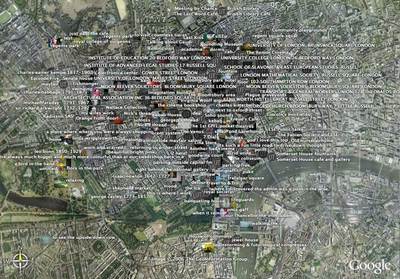
A 'Pocket' in Urban Tapestries is the relationship a person make to a geographic place, and which can be filled with text (including HTML tags), audio, images and video clips. The original UT prototype could only create single point pockets (much like sticking a pin into a map), but we have enabled the new system to support multi-point, or polygonal, pockets. Now it is possible to mark off a whole area, such as a building or a stretch of street or a specific feature in the landscape (for instance a pond, fountain or tree). Three types of pocket can thus be created: points, lines and clusters.
What this enables is more complex relationships to places to be articulated, bringing in concepts like time and duration to the mapping of experiences, as well as knowledge and more basic information. The image below shows a Thread with several 'cluster' pockets of Coram's Fields in Bloomsbury. The cluster pockets are of a building (the Foundling Museum), a paddling pool, a cafe seating area, a petting zoo and one of the buildings.
We have also been developing a Flash client for the new UT system: here are some work-in-progress screenshots showing pockets and threads overlaid over Google Maps, retrieving street addresses (from the OS MasterMap geodata) by hovering over the map and displaying pocket contents:
Here is a first preview of one of the new interfaces to Urban Tapestries. In particular, this interface uses Google Maps to provide the mapping visualisation which we have overlaid with the sensor tracks from our Feral Robots test in London Fields back in early February. More details at the presentation on Friday at the Takeaway Festival.
Update: some links to reviews and blog posts on other sites:
Robot Reads London Park
GoRobotics
context weblog
After more than three years of planning and developing we began a small alpha trial this week of the DIFFUSION Generator. This is another pillar of our public authoring concept, enabling people without graphic design skills or access to professional desktop publishing software (such as Quark XPress or Adobe InDesign) to use our DIFFUSION eBooks format as a new form of internet distributed, tactile, on demand publishing.
We plan to test the system thoroughly over the coming months and hope to launch a public beta test of the first version in June. Later in the year we plan to add the Generator's instant publishing capabilities to the new Urban Tapestries system, allowing users to create 'pocket' postcards and 'thread' posters as we proposed last year. In early 2007 we also hope to add the StoryCube template to the Generator, enabling people to publish not just eBooks, but their own StoryCubes as well.
The image below is a screenshot of the sketchpad area of the Generator where people add in their writings and begin to format the text. This is the first of four stages in the eBook publishing process – once the finished eBook is generated the creator has the option to publish it into the DIFFUSION Library alongside all the other titles published since 2000 by Proboscis.
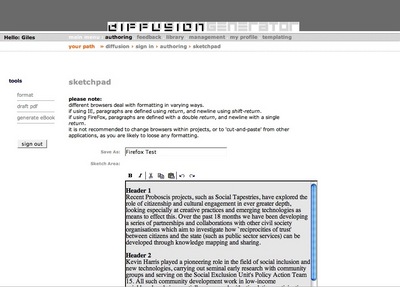
Robotic Feral Public Authoring
A short film (1 minute Quicktime MP4) of the field trial in London Fields last Friday.
Initial Visualisations of the sensor readings/map:
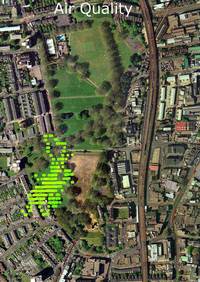 +
+ 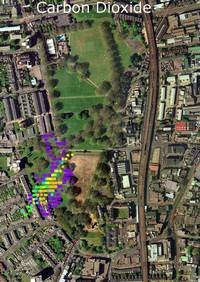
![]()
Documentation from last November's Community Mapping Workshop in London Fields.
The first live trial of the Proboscis/Birkbeck Feral Robot took place in London Fields today:
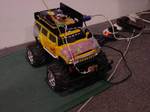
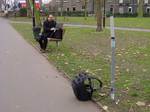
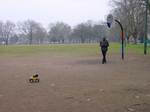
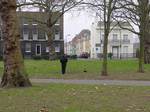
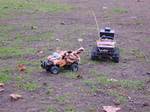
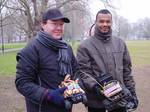
A group from Proboscis (Giles Lane, Sarah Thelwall, Orlagh Woods and Camilla Brueton) and Birkbeck College Computer Science dept (George Roussos and Dima Diall) braved the freezing weather to test the robot out in the field. We adapted a Locustworld meshbox to act as a battery powered mobile mesh node with SPACE Media's wifi network broadcasting into the southern part of London Fields. A 9dB antenna gave us a powerful signal extending the wifi mesh right across the park which the robot connected to, sending back around 1700 data packets to the Urban Tapestries server over the space of about an hour. The robot took sensor readings (air quality and carbon dioxide) approximately every two seconds, together with a GPS location fix to enable the reading to be correlated with a map and with other forms of local knowledge posted on the UT platform. Alongside our own feral robot, we gave a robot designed by Natalie Jeremijenko for the Ark Centre in Dublin last summer a test run in the fields, its sensor attuned to 'solvent vapours'. However, as it isn't able to store or transmit its readings we were not able to determine what, if anything, it encountered.
The data captured from the public authoring robot will be analysed and an online visualisation of the test results posted next week (along with some video footage). We hope to have a more extensible interface for overlaying and interrogating sensor readings and local knowledge in March. Thanks to Richard Lander at Locustworld for timely assistance with the meshing protocols, Peter Chuancy at SPACE and George Papamarkos manning the UT system back at Birkbeck.
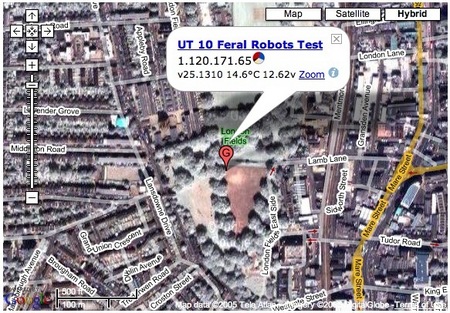
A Locustworld Mesh Map
Update: blogged by Guy Kewney's Mobile Campaign, "Glue-sniffing robot meets wireless mesh robot in London Park - romance?"
The first of 2 planned Robotic Feral Public Authors has been completed and is ready for its first field trial in London Fields next week:
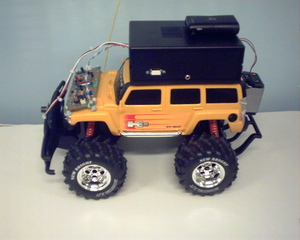
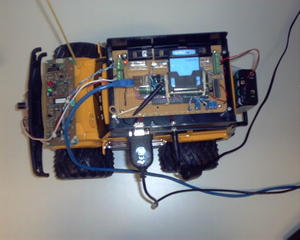
The robot has two sensors (air quality and carbon dioxide) and GPS location sensing. The sensors were selected to reflect the concerns voiced in our community pollution mapping workshop back in November, which identified air pollution as the key environmental issue of local residents. The robot communicates its Lat/Long position and sensor readings back to the Urban Tapestries public authoring system via a WiFi connection. For the field trial in London Fields we will be meshing two battery-powered Locustworld meshboxes with SPACE's own public WiFi network.
The robot has been built by Dima Diall at Birkbeck College/London Knowledge Lab, with assistance from Dimitri Airantzis and Dr George Roussos. The integration with Urban Tapestries and data visualisation of the sensor traces has been achieved by George Papamarkos. Results from the field trial will be posted shortly.
Over the last three years of research on Urban Tapestries and Social Tapestries we've been grappling with the problem of how the knowledge contributed to a public authoring system would reach people who didn't have the kinds of emerging mobile technologies that we were specifically investigating.
As we worked with people from different walks of life, age groups and social and economic backgrounds it became clear that there are many reasons why people will or will not adopt certain technologies. Perhaps because they can't be bothered, or cannot for economic reasons; or are comfortable with other technologies (television, teletext etc)...
As Social Tapestries starts to work with some specific communities we've begun to address these directly, planning and building into the next generation of the Urban Tapestries software platform the capability to respond to some of these possibilties.
Two we are particularly pleased to share are print-based. In thinking about the structure of Urban Tapestries – the Pockets and Threads – we drew parrallels with existing real world media: postcards and posters. Our plan is to integrate a PDF engine (similar to the work we are doing on another Proboscis project, the DIFFUSION eBook Generator) to allow people to create PDFs that can print off pockets as postcards (A6), and threads as posters (A3)...
The sorts of things we think these postcards and posters could be used for include:
• direct distribution within the community to make local knowledge more widely accessible
• posting them to friends and relatives
• displaying them on community noticeboards or in shop windows
• as a tool for political activism, e.g. sending them to a local councillor or MP
John Paul Bichard's Neighbourhood Games is an ongoing research project for Social Tapestries and part of his larger exploration of gaming in the everyday, Embedded Games. John is collaborating with both Proboscis in London and the Interactive Institute in Stockholm (on the Back Seat Playground project) to develop models for a Real World Game Engine.
"By associating game properties to real world objects, much in the same way that a videogame uses an object orientated approach to associate properties and rules to modelled and textured objects, real world objects can be organised and related to form embedded game environments.
"Neighbourhood Games sets out to explore the possibilities of introducing cross-media games into the everyday neighbourhood environment, to propose ways in which games can be meaningfully structured across a broad range of channels, including fixed and mobile digital spaces and the 'real' environment of the local neighbourhood."
John and his wife Louisa are currently on their 2220 expedition – a 60 day journey around the coast of Sweden by kayak.
We are extremely pleased to announce that the UT Web Browser and location-based RSS Feeds are now available for people to explore content created on the system during the trials. We'll be adding further content to the system over the coming months to demonstrate a range of possible uses of public authoring. We are also hoping to run further trials in 2005.
Due to copyright restrictions (on our use of Ordnance Survey map data) users of the Web Browser will have to request a username and password.
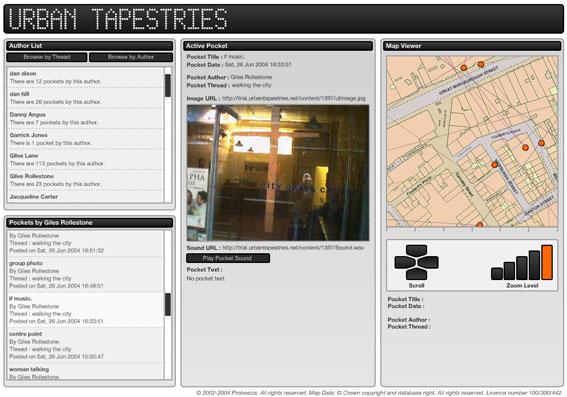
The web browser for Urban Tapestries is nearing completion and we should be able to allow access within a few weeks. For copyright reasons users will have to register to use it. Meanwhile here's a sneak preview of the interface:
The UT Web Browser has been programmed by Michael Golembewski.
The RSS feeds from Urban Tapestries are complete and will be released with the forthcoming Web Browser. Meanwhile here's an image of a feed in NetNewsWire running on Mac OS X:
The UT RSS Feeds were programmed by Paul Makepeace.
Two views of threads created by participants in our trials:
June 2004
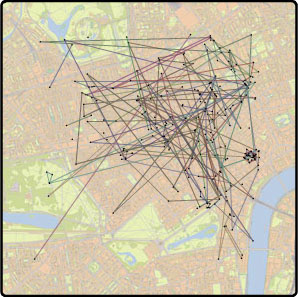
December 2003
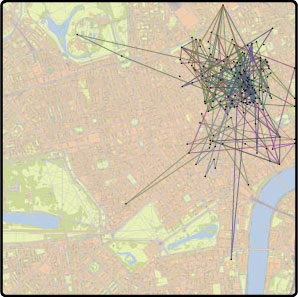
We now have a map of all the pockets and threads that the trial participants created on the system during December 2003 and June/July 2004.
A larger version can be viewed on the main UT website.
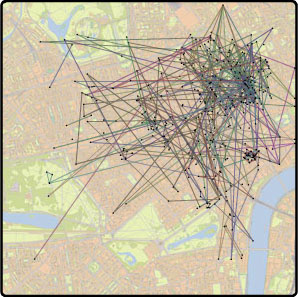
Proboscis is currently working on making the system content accessible to the general public via RSS feeds for newsreaders and a Flash Web Viewer. We are working RSS feeds that should allow people to subscribe to all new pockets on the system or to individual authors, or threads, or major towns or local areas.
The web viewer will be a graphical viewer (authoring capabilities to come in Prototype 2.0 Spring 2005) for the UT system content from the June 2004 trial, giving an insight into the possibilities of spatial annotation using high-definition mapping.
We anticipate releasing these in late September 2004 – announcements will be made here.
We've posted our development roadmap for UT today which sketches out the broader set of functionalities we believe that a public authoring / spatial annotation system like UT would ultimately need to be powerful, flexible and responsive to the needs and desires of local people capturing and sharing local knowledge.
The functions have been grouped in three phases for implementation (above and beyond the functionality of the existing prototypes): basic, intermediate and advanced. Proboscis is proposing to implement these in stages as we raise funding and secure partnerships and collaborations to develop the overall project.
The field trial is now coming to a close and we've been exceptionally fortunate to have had participants willing to share their experiences with us, as well as the content they've entered into the system. Many thanks from Proboscis and our partners to all of you.
Our next task is to begin the daunting task of collating and evaluating the participant feedback, analysing their threads and pockets on the system, as well as analysing the system logs. We hope to build up a picture of why, what, where, when and how often the system was used. Coupled with the experiential feedback from the participants this should become an invaluable resource for looking at the future of mobile data services and spatial annotations systems. We'll be publishing the results in September in a commercial / policy white paper, as well as online. Meanwhile you can sample some extra-curricular notes from participant Dan Hill here and here.
We are particularly pleased to report that, aside from frustrations with the slowness of GPRS and the P800, none of the participants suffered any major problems requiring technical support. Our worst mishap seems to have been the loss of one phone in a burglary!
Our next task is to build a web viewer to allow remote access to the UT system which we hope to have ready by late July/early August (pending license agreements with the Ordnance Survey).
Some of our ideas for future Urban Tapestries prototypes are taking shape and can be viewed here.
They address the long-term proposal for UT to become a p2p or distributed server platform; a shorter term proposal to re-fit our existing Locustworld MeshBoxes with hard drives and use them as extremely local UT servers providing content to wireless clients; and a range of possibilities for hybrid forms of location sensing using barcode readers for camera phones, WiFi spotters and near field radio beacons.
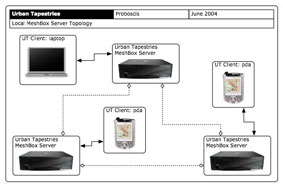
Today is the start of our latest field trial for Urban Tapestries. Proboscis has recruited 9 participants to test the mobile phone version of UT over a 4 week period to give us a sense of why, what for and how people will use it over time. The recruits are all being provided with Sony Ericsson P800s with GPRS connections. Our partners in running the trial, Orange and France Telecom R&D will be recruiting additional staff members (not involved in the project) to take part too. Overall we hope to have between 40 and 50 participants, each testing the system out for 4 weeks.
The trial covers a 3km square area of central London and uses cell triangulation from the Orange network to assist with location sensing. In addition to their actual public authoring using UT, the participants will be completing user experience questionnaires designed by Proboscis (with help from Zoe Sujon at MEDIA@LSE), which aim to help us explore the experiences of authoring, mobility and social and cultural contexts. The server log data will also be analysed to give us an understanding of such crucial issues as time, frequency, type of content, popularity of content etc...
We intend this trial to help build a picture of the future of public authoring technologies such as Urban Tapestries, and to reveal not only the kinds of uses which we have already identified through our own research, but to allow for new ones to emerge simply by having different people use the system over time.
Today we are expecting visits from our partners and stakeholders who will be encouraged to play with the devices, explore the content, read the blog and watch some the participant interviews from the Public Trial. We will then be asking for feedback, suggestions and ideas based on their UT experience.
The trial has finally ended – nine long days with exactly 100 participants. You can read their feedback attached as comments to each day's evaluation post, and see all of the posts in the Trial Evaluation category.
Tomorrow we begin the process of looking back over what has taken place, understanding what we can learn from this experience – not just technically, but also in terms of social and cultural implications arising from what participants have begun to author using the system.
We'll be drawing some conclusions about key themes and issues that emerge from the trial and creating a discussion space here for people interested in Urban Tapestries, public authoring and pervasive communications etc. We welcome contributions to this discussion from everyone, no matter what your interest or reason for taking part.
As we plan and develop the next stage of UT we'll continue to use this blog as part of our ongoing commitment to the open discussion and sharing of ideas, concepts and methods.
Over the last seven days participants have authored and uploaded hundreds of new threads and pockets of content to the system. Here is a sample of some of them;
The joggers challenge - street directions for adventurous running
Now you can see me (NYCSM) - a hide and seek game
Banks to pilfer - a security audit and plan of attack
A day in the life of an urban knitter
Lookalikes - urban spotting of celebrity lookalikes
Chocolate with that - a fictional journey
Clothes - what people are wearing
Strange shops - what they sell and the people that run them
Cool cafes and camera shops - a guide to the best macchiatos and digital deals
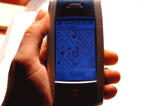
The P800 has finally arrived for the trial, but remains unfinished as the XMLRPC problems were not able to be resolved in time.
Never-the-less we have an exciting and functioning application that works on a mobile phone and contains nearly all of the desired functionality we wished for at this stage of the project. Combined with the iPAQ it is a really exciting step forward for public authoring in the future. Thanks to the team at France Telecom R&D who have made a great effort to develop this application.
I'm stuck up here in Glasgow while the trial is underway :-(
Despite this its great to see the new pockets aggregating on the map, in much the same way as the post-it notes built up on the bodystorimng vinyl map.
I'm also really enoying the users' blogs, much of the comment is highlighting problems we anticipated, and have ideas for solving, but it is so much more real when its real people saying things after having tried it out, than just a conclusion reached at the end of a long meeting. I'm glad that we're managing to engage peoples' imaginations. It is the imagination of the users that will define the "texture" of the experience after all.
Anyway I want to say Thanks and Respect, to the trialists for taking the time and making this such a fun thing to view from afar, and I'm just sorry that we didn't have time to make a more elaborate piece of software.
d.
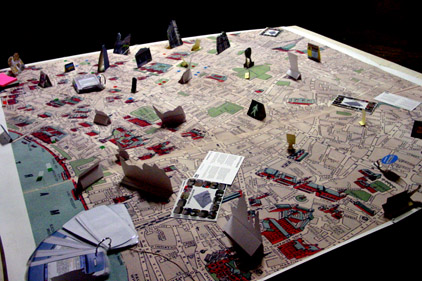
Two days in and we've had 19 devices borrowed and used by participants. Its been a bitterly cold weekend – not ideal weather conditions for an outdoor tech trial – but in some ways good in itself as we've really had to contend with the daily reality of using pervasive mobile devices in the real world.
Having had to postpone the arrival of the P800 mobile phone version due to a bug in its XMLRPC library, we are now hoping that a recently provided fix will mean its trial debut mid-week. Meanwhile the iPAQs have taken the brunt of the testing and have been put through their paces. As expected we've noted a number of bugs and issues, as well as hearing wish list functionality from trial participants that we've already planned in, but had to leave out of this prototype version. A quick bug fix has much improved the speed of the software on the iPAQ, and we hope to resolve further bugs and issues in the software over the next week.
Our mesh has also had its tribulations, as three network outages dropped the number of active nodes and reduced the extent of wifi coverage. Hopefully we will manage to reconnect these nodes to each other during the week – allowing trial participants to spend more time out in the freezing cold!
We've had over 80 bookings for the trial so far, and around 65 places remain available for booking until the 6th December. From then on bookings can only be made one day in advance, and participants will be able to book a second place should they wish to take part again.
To book your place click here.
So far we've had 61 bookings for the trial, with around 90 places still available to book.
We're reserving a few spots on each day to allow for people who just turn up, and we're keeping most of the last day of the trial (Sunday 14th) reserved in case there is last minute scramble to take part.
Booking will continue to be open right up until the 6th December, thereafter we will only take bookings one day in advance. To ensure you have aa place on the trial, follow the instructions on how to book here
The booking system is now ready (a few days later than planned) and information on how to book places on the trial is now up on the project website: here
I've finally suceeded in importing map data from the OS MultiMap XML format into the Urban Tapestries data model, with only minimal changes to our initial model.
This bodes well for the public trial as it ensures that the system will be pre-populated with a rich set of features onto which we can attach content.
This is a major breakthrough as it both allows us to use "real" map data and proves that our system is compatible with the world of "real" map data.
It was the single most important remaining hurdle for the server-side programming effort, and solving it means that we can import the HUGE xml data files supplied by the Ordnace Survey.
Next step.. We need to generate a map image :-(
Back in August we invited a small group of people who are involved or interested in the Bloomsbury area to contribute content to the UT project. They include a taxi driver and poet, light and sound artists, a writer, a historian, a visual artist and more. They were encouraged to produce content in any form - be it a fictional story, factual information, audio, pictures, drawings, linked favourite cafes or bars, personal anecdotes, a map of shortcuts or quiet places – it was up to them. I sent out a Content Contributors notebook with a map of the trial area and pages to add their content. Contributors have been submitting materials electronically and hard copy. All input will be used in the public trial and it is being uploaded to the system now.